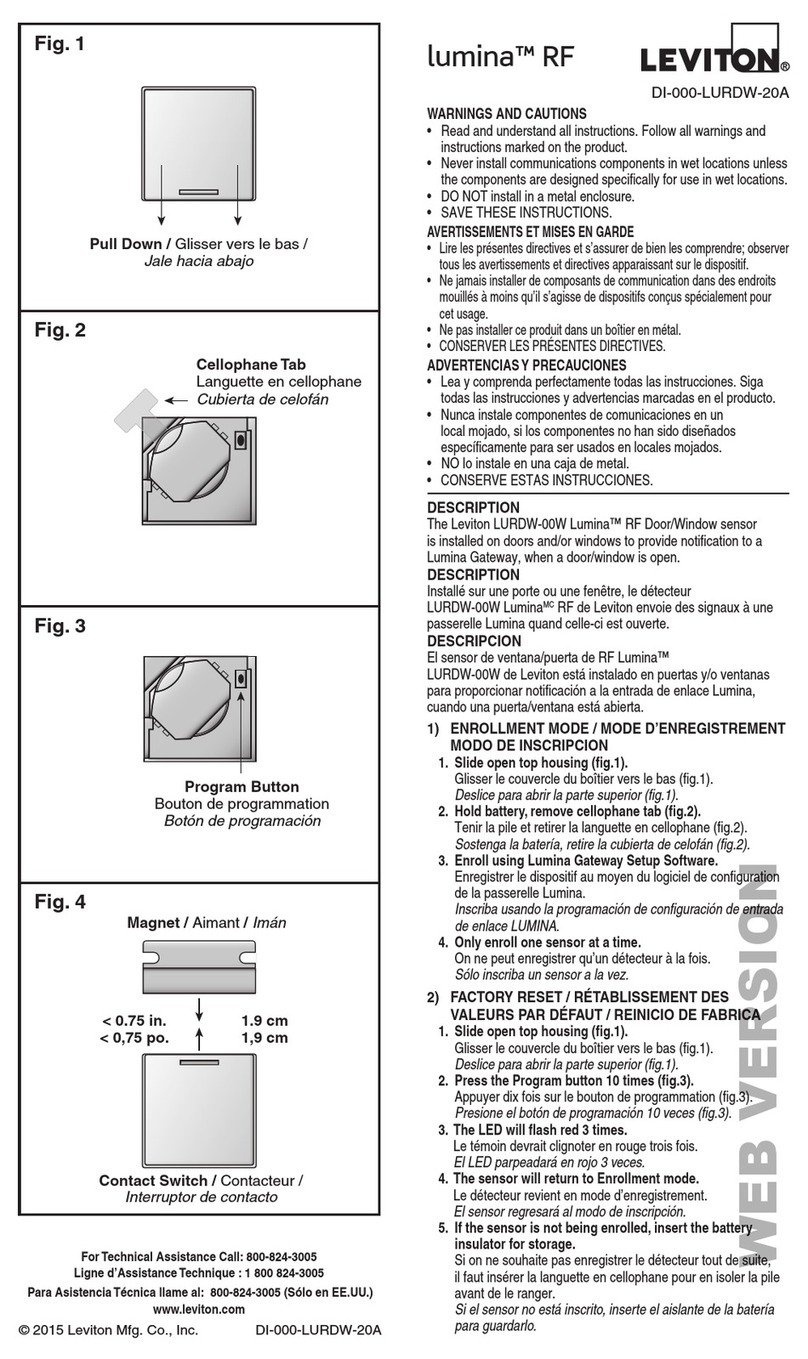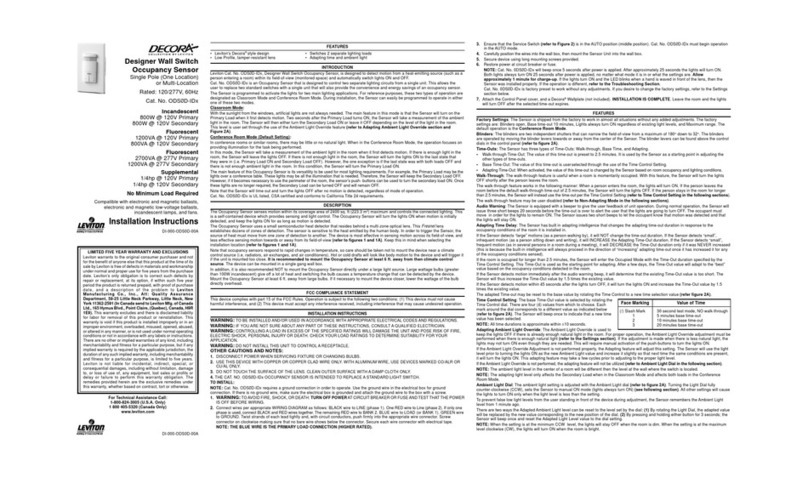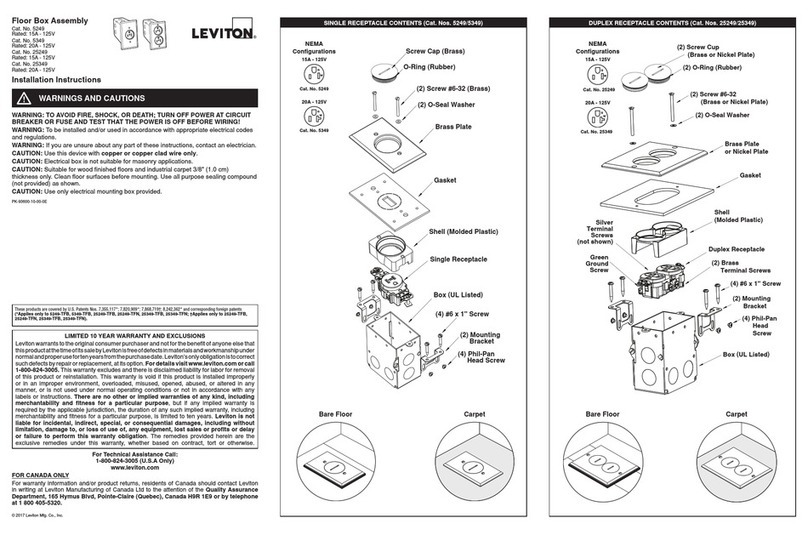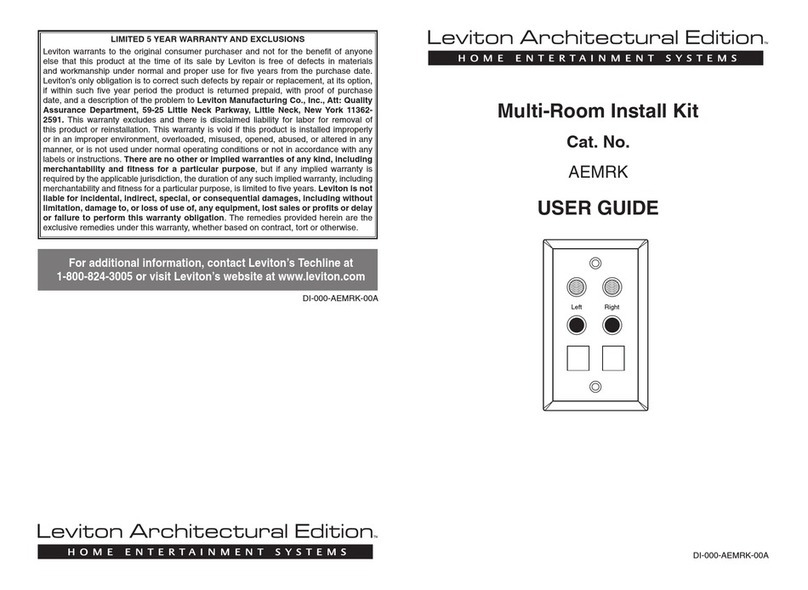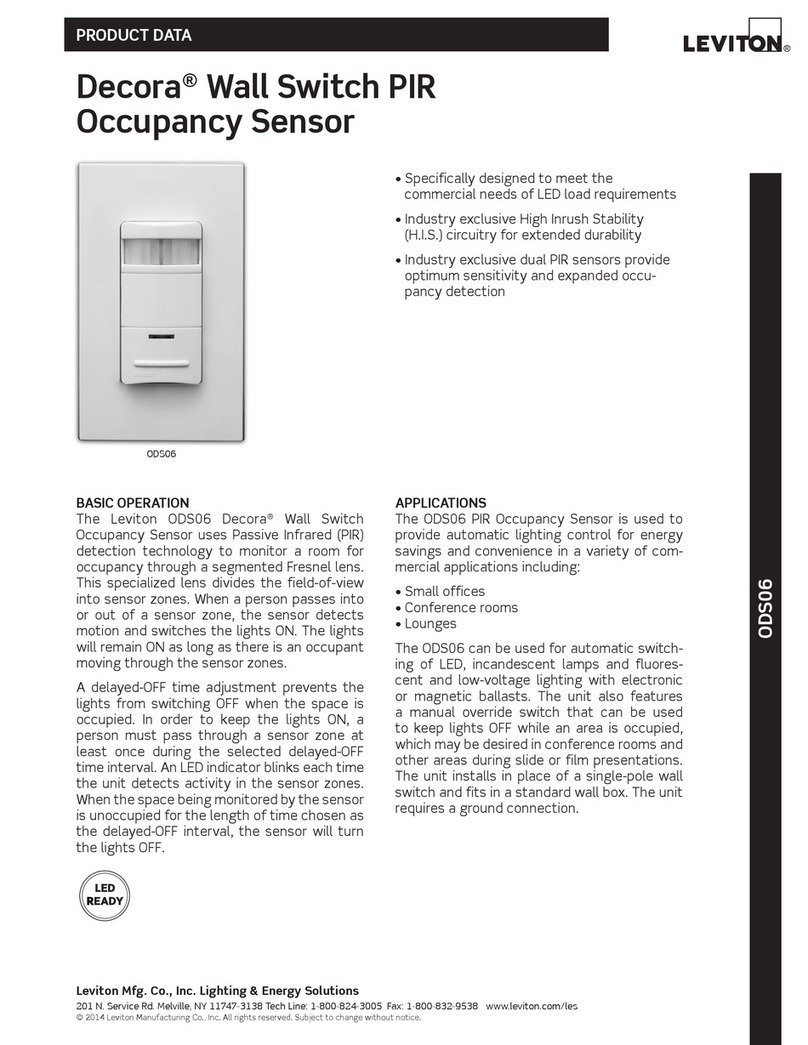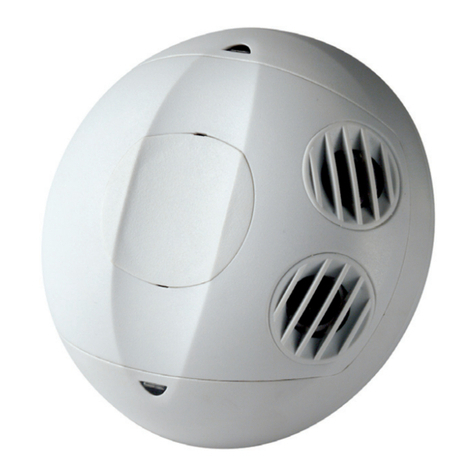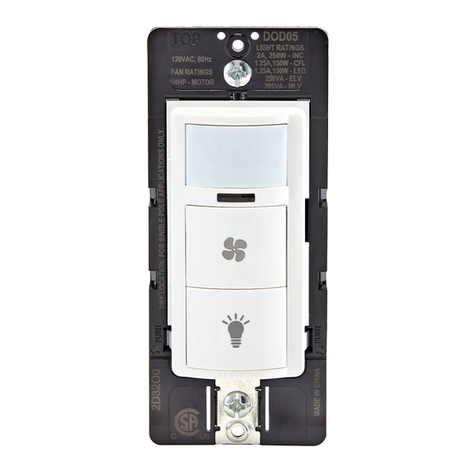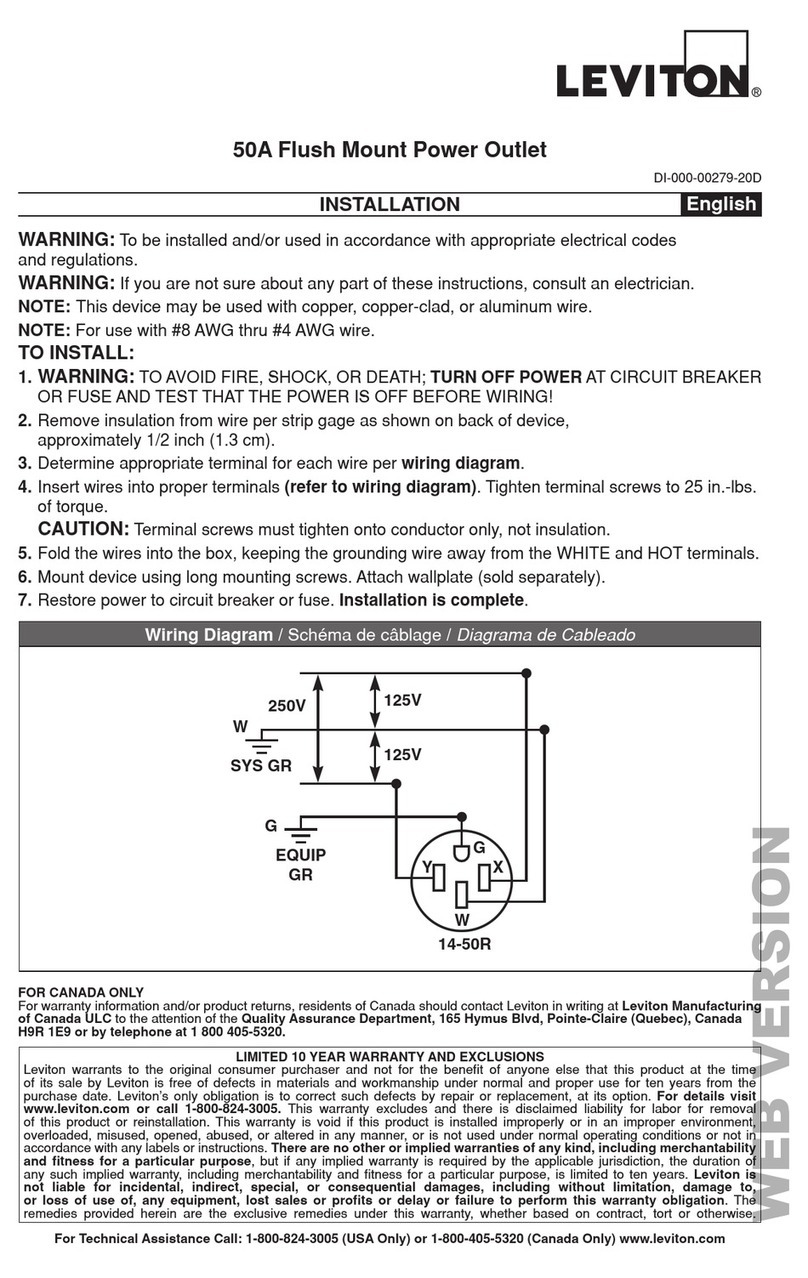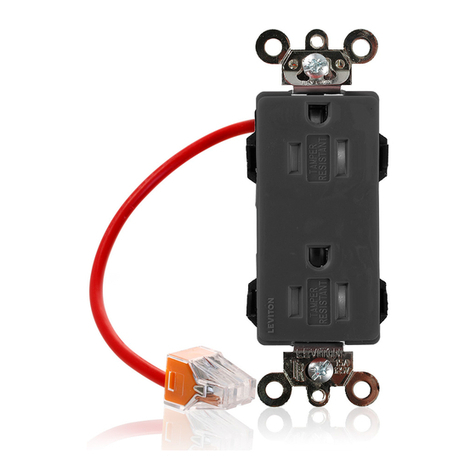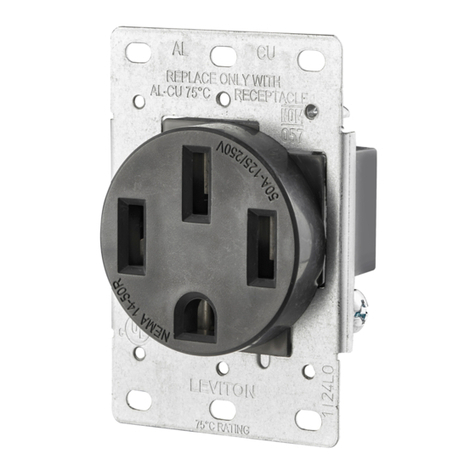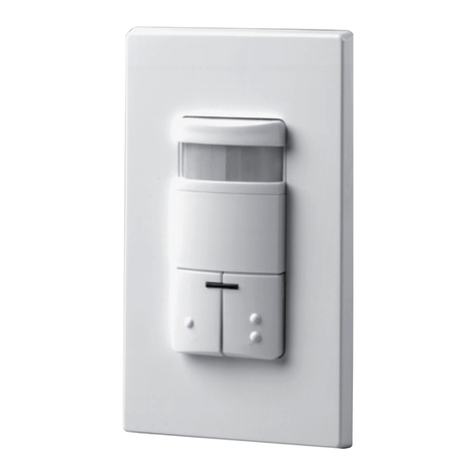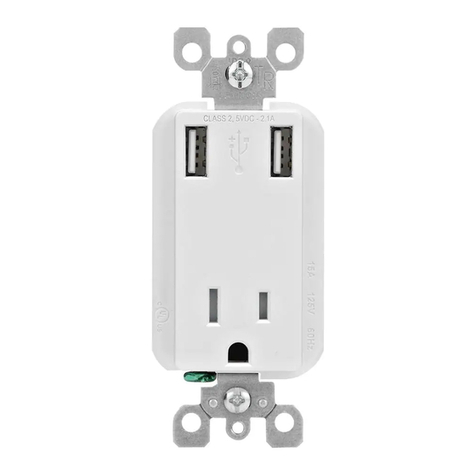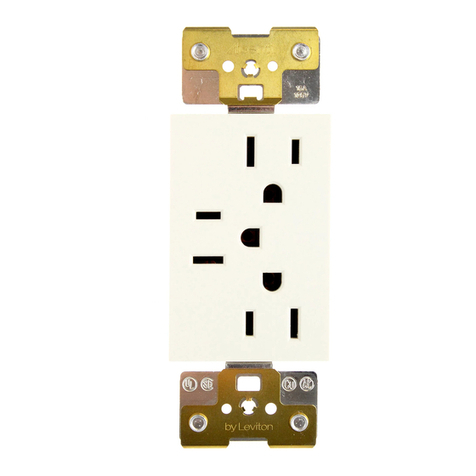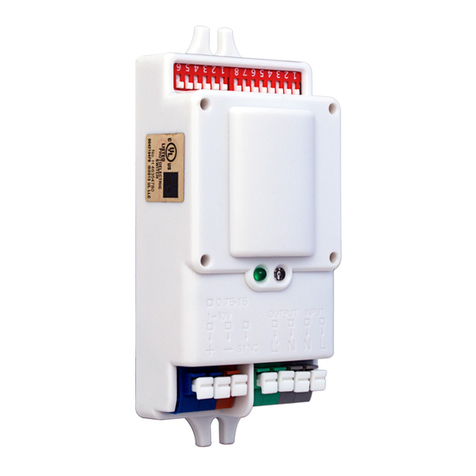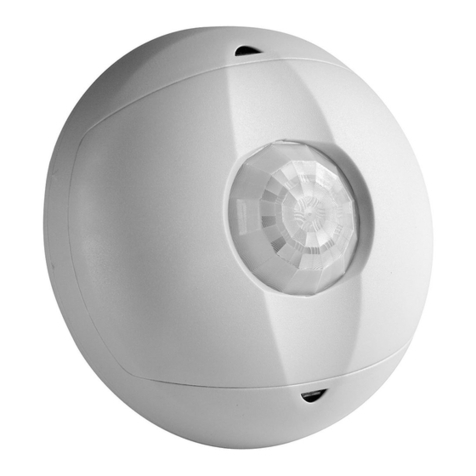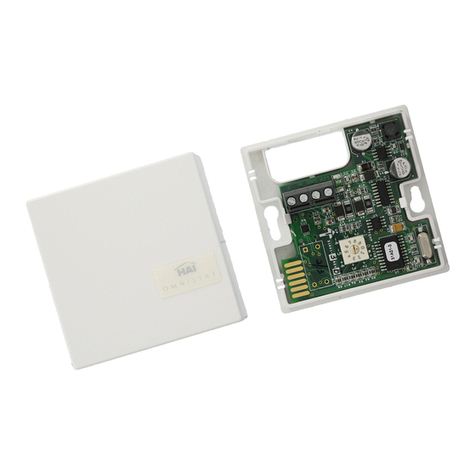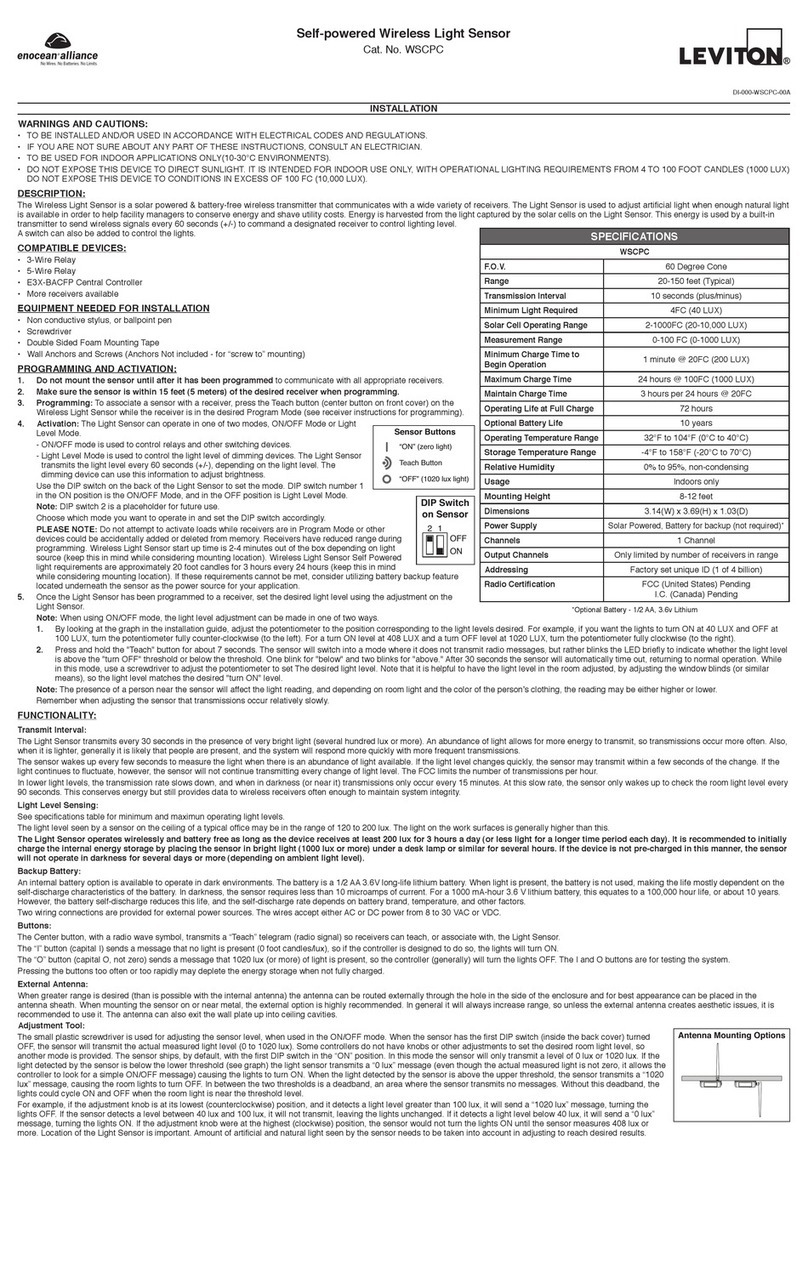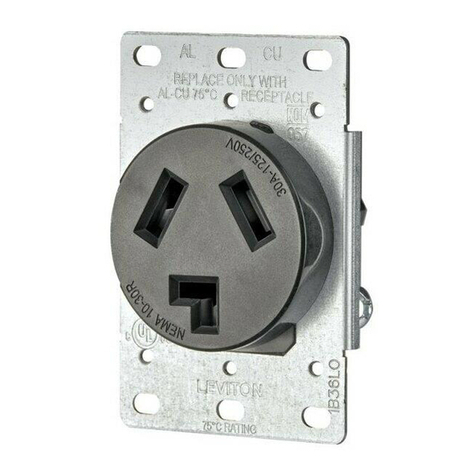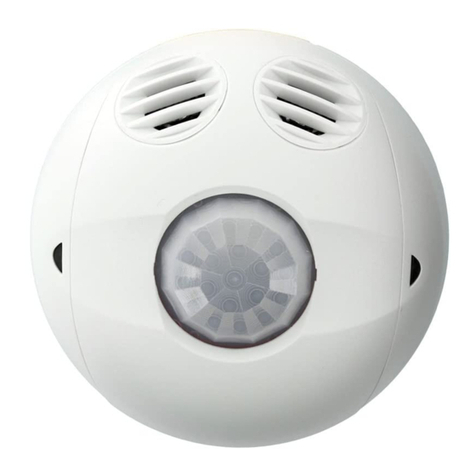FEATURES
DESCRIPTION
Leviton's High Bay Occupancy Sensors, Cat. No. OSFHP, are specifically designed for high mounted areas such as warehouses, manufacturing and other high ceiling applications. The OSFHP installs directly to an industrial luminaire or an electrical junction box. It is a self-contained sensor and relay that detects motion
using the passive infrared (PIR) to sense sources (such as a person entering a room) within its field-of-view (monitored space) and automatically switches lights ON. The controlled lights will remain ON until no motion is detected and the scheduled time-delay has expired. The OSFHP is supplied with two interchangeable
lens rings that allows the user to select between a 360 degree High Bay/Low Bay pattern or an aisle pattern.
Cat. No. OSFHP is UL/cUL listed and conforms to California Title 24 requirements. The Sensor's High Bay lens is designed for 20 ft. to 40 ft. mounting heights for a symmetrical pattern which will provide coverage of 50' to 60' diameter (refer to Figure 4 and 5). The Low Bay lens is designed for 8 ft. to 20 ft. mounting
heights for a symmetrical pattern which will provide coverage of 30' to 50' diameter (refer to Figure 6). The Sensor is sensitive to the heat emitted by the human body. In order to initially trigger the Sensor, the source of heat must move from one zone of detection to another.
Note that occupancy sensors respond to rapid changes in temperature, so care should be taken not to mount the device near a climate control source (i.e. radiators, air exchanges, and air conditioners). Hot or cold drafts will look like body motion to the device and will trigger it if the unit is mounted too close.
Mount the Occupancy Sensor 6 ft. away from the heating or cooling ventilation source.
INSTALLATION INSTRUCTIONS
WARNING: CONTROLLING A LOAD IN EXCESS OF THE SPECIFIED RATINGS WILL DAMAGE THE UNIT AND POSE RISK OF FIRE, ELECTRIC SHOCK, PERSONAL INJURY OR DEATH. CHECK YOUR LOAD RATINGS TO DETERMINE THE UNIT’S SUITABILITY FOR YOUR APPLICATION.
WARNING: IF YOU ARE NOT SURE ABOUT ANY PART OF THESE INSTRUCTIONS, CONSULT AN ELECTRICIAN.
WARNING: TO BE INSTALLED AND/OR USED IN ACCORDANCE WITH ELECTRICAL CODES AND REGULATIONS.
OTHER CAUTIONS AND NOTES:
1. DISCONNECT POWER WHEN SERVICING LUMINAIRE OR CHANGING BULBS.
2. USE THIS DEVICE WITH COPPER OR COPPER CLAD WIRE ONLY.
3. DO NOT ATTEMPT TO DISASSEMBLE OR REPAIR. CLEAN OUTER SURFACE WITH A DAMP CLOTH ONLY.
TO INSTALL:
NOTE: The OSFHP is supplied with two lens trim rings. The 360 degree High Bay lens (white color trim ring) is installed at the factory with the Low Bay lens (blue color trim ring) in the carton. Choose the correct lens for your fixture height location and add the black aisle mask if desiring to block
detection outside of the aisle. See below for changing lens trim ring. The OSFHP Sensor mounts in a 1/2" knock out hole on the end of a luminaire or an electrical box. The Sensor’s field-of-view may be partially obstructed by the luminaire housing (refer to Figure 1A). At higher mounting heights,
the outer beams are not used. As long as the bottom of the sensor is mounted within 1" from the bottom of the luminaire, the field-of-view will not be affected (refer to Figure 1B).
ADAPTER NOTE: For deep bodied luminaires or to clear other obstructions use Leviton's OSFOA-00W Adapter. The Adapter is designed to provide multiple mounting positions to accommodate different mounting heights for optimum sensor positioning. A keyed, threaded snap-in nipple that
holds the Adapter in place while tightening the provided lock-nut. The OSFLO is a single height position adapter with a quick install snap in fitting without a lock nut.
SENSOR INSTALLATION:
1. WARNING: TO AVOID FIRE, SHOCK, OR DEATH; TURN OFF POWER AT CIRCUIT BREAKER OR FUSE AND TEST THAT THE POWER IS OFF BEFORE WIRING.
2. The sensor comes with two lens rings, a white one for 360 degree High Bay detection (installed at factory), and a blue one for Low Bay applications.
NOTE: Masking is provided to customize your detection area. Aisle mask can be inserted inside the lens and an optional peel and stick masking kit is included. This circular white adhesive label (with removable wedges) is applied to the OUTSIDE of the sensor lens.
Use any number of wedges to alter field-of-view for your desired application.
3. To change lens, turn trim ring so that the two indented dots line up and pull out by the finger tabs (refer to Figure 7A).
4. If desired, insert black aisle mask into underside of lens assembly. NOTE: Position aisle mask according to aisle direction (refer to Figure 7B).
5. Line up dots and turn trim ring to set lens.
6. Remove the lock-nut from the threaded nipple and insert the wires and the threaded nipple into a half inch hole of the luminaire body or the electrical box.
NOTE: Mounting nipple has a “snap” feature for quick installation into round or “double-D” holes, as well as a “keying” mechanism to prevent rotation after installation in “double-D” holes.
7. Slide the lock-nut over the wires and thread clockwise on to the threaded nipple to secure the sensor firmly in place making sure the lens is orientated towards the area to be monitored (field-of-view) (refer to Figure 3).
8. Connect wires per Wiring Diagram as follows: BLACK leads to LINE (Hot); RED leads to LOAD; WHITE leads to NEUTRAL. Twist strands of each lead tightly and, with circuit conductors, push firmly into the appropriate wire connector.
Screw connector on clockwise making sure that no bare wire shows below the connector.
9. Restore power at circuit breaker or fuse.
NOTE: Allow approximately 1 minute for charge-up. If the lights turn ON and the LED blinks when a hand is waved in front of the lens, then the Sensor was installed properly. If the operation is different, refer to the TROUBLESHOOTING Section.
The Sensor is factory preset to work without any adjustments. If you desire to change the factory settings, refer to the SETTINGS section.
The OSFHP-ITW product models have wire pigtails exiting from the enclosure described in Table 1: OSFHP-IT Wire Table.
The OSFHP-I4W product models have wire pigtails exiting from the enclosure described in Table 2: OSFHP-I4 Wire Table
The Low Voltage product model (OSFHP-ILW) product models have wire pigtails exiting from the enclosure described in Table 3: OSFHP-IL Wire Table.
PK-93962-10-00-2C
High Bay/Low Bay Passive
Infrared Single Relay Occupancy Sensor
Cat. No. OSFHP-ITW (Sensor)
Cat. No. OSFHP-I4W (480V Sensor)
Cat. No. OSFHP-ILW (Low Voltage Sensor)
Cat. No. OSFOA-00W (Adapter, sold separately)
Cat. No. OSFLO-00W (Adapter, sold separately)
Ratings:
The product models with input voltage of 120 - 347VAC
have the following electrical ratings:
800VA @ 120VAC, 50/60Hz, Ballast
1000VA @ 230VAC, 50/60Hz, Ballast
1200VA @ 277VAC, 50/60Hz, Ballast
1500VA @ 347VAC, 50/60Hz, Ballast
The product models with input voltage of 120 - 347VAC
have a motor rating of ¼ HP at 120VAC.
The product models with input voltage of 480VAC
have the following electrical ratings:
2000VA @ 480VAC, 50/60Hz, Ballast
The low voltage (OSFHP-IL) product model
have the following electrical ratings:
Input – 24VDC/VAC, 50/60Hz, 20mA
HVAC Relay – 1 A, 30VDC
Compatible with electronic and magnetic ballasts, electronic
and magnetic low-voltage transformers.
INSTALLATION INSTRUCTIONS
• 360 degree lenses for field-of-view (included):
- Blue Lens = 8-25ft mounting height
- White Lens = 20-40ft mounting height
• H.I.S. (High Inrush Stability) Technology
- Zero Crossing
- Robust Mechanical Latching Relays
• Fixture or electrical box mounted Passive Infrared Occupancy Sensor
• Integrated Rotational Photocell
• Adjustable Time Delay
• Manual and Auto Calibration
• 21" pre-stripped color coded wire leads
• Optional peel and stick mask kit
• Aisle Coverage: add included aisle mask to either lens option
• Non-Volatile Memory, device returns to its last state during power interruption
• LED indicator light blinks when sensor detects motion , visible from long distance
• False Detection Circuitry
• Offset Adapters (sold separately)
Table 1: OSFHP-IT
Wire Table
Color Description
Black Line
Red Load
White Neutral
Table 2: OSFHP-I4
Wire Table
Color Description
Black Line
Red Load
Adjusting the Setpoint (DDL):
1. If lights turn OFF to soon:
A: Rotate photocell to remove direct light
B: Raise Setpoint above 100% a small amount (repeat as needed)
2. If lights stay ON longer than needed:
A: Rotate photocell toward more reflective incoming light
B: Lower Setpoint below 100% a small amount (repeat as needed)
For Technical Assistance Call: 1-800-824-3005 (USA Only)
or 1-800-405-5320 (Canada Only)
www.leviton.com
LIMITED 5 YEAR WARRANTY AND EXCLUSIONS
Leviton warrants to the original consumer purchaser and not for the benefit of
anyone else that this product at the time of its sale by Leviton is free of defects
in materials and workmanship under normal and proper use for five years
from the purchase date. Leviton’s only obligation is to correct such defects by
repair or replacement, at its option. For details visit www.leviton.com or call
1-800-824-3005. This warranty excludes and there is disclaimed liability for
labor for removal of this product or reinstallation. This warranty is void if this
product is installed improperly or in an improper environment, overloaded,
misused, opened, abused, or altered in any manner, or is not used under normal
operating conditions or not in accordance with any labels or instructions. There
are no other or implied warranties of any kind, including merchantability
and fitness for a particular purpose, but if any implied warranty is required by
the applicable jurisdiction, the duration of any such implied warranty, including
merchantability and fitness for a particular purpose, is limited to five years.
Leviton is not liable for incidental, indirect, special, or consequential
damages, including without limitation, damage to, or loss of use of, any
equipment, lost sales or profits or delay or failure to perform this warranty
obligation. The remedies provided herein are the exclusive remedies under
this warranty, whether based on contract, tort or otherwise.
FOR CANADA ONLY
For warranty information and/or product returns, residents of Canada should contact
Leviton in writing at Leviton Manufacturing of Canada ULC to the attention of
the Quality Assurance Department, 165 Hymus Blvd, Pointe-Claire (Quebec),
Canada H9R 1E9 or by telephone at 1 800 405-5320.
SETTINGS AND CALIBRATION
Calibration:
1. Power up device (1 second PIR stabilization, 1 minute total charge time)
2. Decide on Manual or Auto configuration (Auto Recommended)
3. Manual Calibration:
• Manual calibration should be done when ambient light is at user’s desired brightness
• Position photocell towards incoming light
• Turn dial to SET/OFF for 5 seconds
• LED blinks
• Turn dial back to 100% setpoint, this determines DDL (Design Daylight Level)
• LED blinks for 5 minutes
• Verify DDL by turning dial above and below 100% to cycle the load
• To Cancel Manual Calibration
• Turn dial to SET/OFF for five seconds
• Begin desired calibration process (Auto or Manual) over
4. Auto Calibration:
• Turn dial to AUTO for 5 seconds
• LED Blinks
• Initiates 24 hour calibration sequence
• After 24 hours the DDL is set
• To Cancel Auto Calibration
• Move dial to % then back to AUTO
• Begin desired calibration process (Auto or Manual) over
5. Disable Photocell
• To disable photocell completely turn dial to SET/OFF
OPERATION
Timer Delay Application:
The primary time delay shall start counting (or restart) from time zero whenever the sensor detects movement.
For single load product models the sensor shall change state to unoccupied when the primary time delay expires.
Photocell and Daylighting Operations:
Daylighting is used for additional energy savings. For all models, load one is affected by the photocell. The photocell holds the lights off
when sufficient ambient light is available. Typical light level is measured in foot candles or lux, and average office rooms are designed to
50-60 foot candles/500-600 lux. The design daylight level when set per calibration section will be the setpoint and engage the light hold-off
feature of daylight harvesting.
• Rotating the photocell on these devices can create a closed loop system (most common), an open loop system or some of each.
• When the photocell is pointed up, it is typically pointed at a skylight. It will only detect daylight. There will be little or no contribution
from the fixtures. The graph in Figure 2A tracks the value of a linear photocell throughout a day. It is assumed that it is a cloudless
day so the increase and decrease of the daylight is relatively linear. The far left of the graph starts out at night and shows a very low
level reading. At dawn, the level begins to increase. At some point, based on the setting of the trigger point, the lights will be turned off
since there is enough contribution from the daylight. The photocell reading will begin to decrease around noon until the level matches
the trigger point, then lights will be turned back on.
• When there is little or no light contribution from the fixtures, the system is relatively simple and stable. In order to keep the lights from
needlessly cycling on and off, the off trigger point is usually set at a higher light level than the on trigger point. In addition, there is
usually a delay time that must be met which requires the light level to be above or below the trigger point for a period of time before
a light change occurs. For example, there may be a 5% hysteresis gap between the off and on trigger points along with a 5 minute
delay time to turn off the load and 1 minute time delay to turn on the load.
• When the sensor is pointed down, it will typically detect light contributions from both the fixtures it controls and the ambient light
from outside sources. This establishes a closed looped system. Switching loads off in a closed loop system rather than dimming
can cause complications if not programmed properly. The graph in Figure 2B tracks the value of a linear photocell throughout a
day. It is assumed that it is a cloudless day and that the desired light level is the same level without external light influence and only
by the fixtures. At the far left, the lights are on because the area is occupied and since it is still night, there is no contribution from
daylighting. As dawn arrives, the photocell level begins to increase as the daylight increases. In order to keep the light level from
dropping below the trigger point, and in this case below the desired light level in the area, the trigger point is set to 2.5 times the level
read with only the fixtures. That way, the light is still adequate to hold the lights off. This is shown in the graph at the point where
the level suddenly drops. The photocell level then continues to increase until around noon. As the daylight decreases, the area light
eventually drops to near the desired light level. Before reaching this point the lights are turned back on indicated by the sudden
increase in the photocell level.
FACTORY SETTINGS
Configuration Value
Timer 30 seconds
PIR Sensitivity 75% of Maximum
Photocell Set Point Off
Installed Lens Gray, High Bay
Lens Position
Zero rotation
position, Lens tabs
aligned with side
90° markings.
TIMER 1 DELAY
30
SEC
30
MIN
10
20
5
SETPOINT
SET/
OFFAUTO
100%
250%
25%
